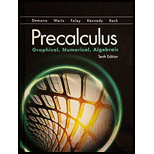
a.
To find: The number of 4th great grandparents and their generation.
The number of 4th great grandparents is 64. They are generation 6.
Given information:
Current(1) generation: 0.
Parents’(2) generation: 1.
Grandparents(4) are generation 2.
Great grandparents are generation 3.
2nd great grandparents are generation 4.
Calculation:
Number of individuals in each generation following exponential model
Great grandparents:
2nd great grandparents:
3rd great grandparents:
4th great grandparents:
b.
To find: The exponential function for nth great grandparents.
Exponential function for nth great grandparents:
Given information:
Current(1) generation: 0.
Parents’(2) generation: 1.
Grandparents(4) are generation 2.
Great grandparents are generation 3.
2nd great grandparents are generation 4.
Concept used:
Exponential function:
Explanation:
Number of individuals in each generation following exponential model
There are 8 first great grandparents and
Exponential function for nth great grandparents:
c.
To find: The number of 6th great grandparents.
The number of 6th great grandparents is 256.
Given information:
Current(1) generation: 0.
Parents’(2) generation: 1.
Grandparents(4) are generation 2.
Great grandparents are generation 3.
2nd great grandparents are generation 4.
Explanation:
Exponential function for nth great grandparents:
Put
The number of 6th great grandparents:
The number of 6th great grandparents is 256.
d.
To find: The number of 25th great grandparents.
The number of 25th great grandparents is 134217728.
Given information:
Current(1) generation: 0.
Parents’(2) generation: 1.
Grandparents(4) are generation 2.
Great grandparents are generation 3.
2nd great grandparents are generation 4.
Explanation:
Exponential function for nth great grandparents:
Put
Number of 25th great grandparents will be
e.
To find: The percentage of people in 1250 related to the person in generation 1.
About 8.4% of the population in 1250 is related to the person in generation 0.
Given information:
Current(1) generation: 0.
Parents’(2) generation: 1.
Grandparents(4) are generation 2.
Great grandparents are generation 3.
2nd great grandparents are generation 4.
World’s population in 1250 is 400 million.
Explanation:
Exponential function for nth great grandparents:
For 25 generation,
The number 23rd great grandparents:
Also,
About 8.4% of the population in 1250 is related to the person in generation 0.
Chapter 3 Solutions
EBK PRECALCULUS:GRAPHICAL,...-NASTA ED.
 Calculus: Early TranscendentalsCalculusISBN:9781285741550Author:James StewartPublisher:Cengage Learning
Calculus: Early TranscendentalsCalculusISBN:9781285741550Author:James StewartPublisher:Cengage Learning Thomas' Calculus (14th Edition)CalculusISBN:9780134438986Author:Joel R. Hass, Christopher E. Heil, Maurice D. WeirPublisher:PEARSON
Thomas' Calculus (14th Edition)CalculusISBN:9780134438986Author:Joel R. Hass, Christopher E. Heil, Maurice D. WeirPublisher:PEARSON Calculus: Early Transcendentals (3rd Edition)CalculusISBN:9780134763644Author:William L. Briggs, Lyle Cochran, Bernard Gillett, Eric SchulzPublisher:PEARSON
Calculus: Early Transcendentals (3rd Edition)CalculusISBN:9780134763644Author:William L. Briggs, Lyle Cochran, Bernard Gillett, Eric SchulzPublisher:PEARSON Calculus: Early TranscendentalsCalculusISBN:9781319050740Author:Jon Rogawski, Colin Adams, Robert FranzosaPublisher:W. H. Freeman
Calculus: Early TranscendentalsCalculusISBN:9781319050740Author:Jon Rogawski, Colin Adams, Robert FranzosaPublisher:W. H. Freeman
 Calculus: Early Transcendental FunctionsCalculusISBN:9781337552516Author:Ron Larson, Bruce H. EdwardsPublisher:Cengage Learning
Calculus: Early Transcendental FunctionsCalculusISBN:9781337552516Author:Ron Larson, Bruce H. EdwardsPublisher:Cengage Learning





